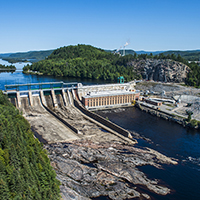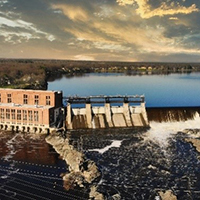How Hydro‑Québec installations reduce the impact of spring runoff
Each year, our experts work actively to make the best use of our network of facilities in order to limit the impact of spring runoff on populations.
For more information:
Hydro-Québec conducted webinars for each of the regions affected by the floods. Watch the 2025 session
And the 2024 sessions [in French, with English subtitles]
Please note that the webinars below present spring runoff data from 2024 and do not necessarily correspond to the situation in 2025. However, the same water management principles are used from year to year.
A tool that identifies flows and water levels
We are installing measuring instruments on rivers and reservoirs where we operate dams and generating stations. They provide flow, water level and meteorological data. This data is available to you through a simple tool, which can provide information about flows on rivers and water levels in reservoirs.
Learn more about the Tool


Specific actions in each region
Wherever Hydro‑Québec has hydropower facilities, we use them to reduce the impact of the spring thaw on residents. A variety of factors specific to each region influences water levels: the size of the watershed, the characteristics of the river system, the type of facility (reservoir or run-of-river), the presence of hydropower facilities belonging to our partners, and above all, weather conditions. Learn more about the water management in your region.
Hydro Québec implements its Plan d'adaptation aux changements climatiques.
Learn about Hydro Québec’s water management strategies for climate change adaptation.
Frequently asked questions
How do Hydro‑Québec facilities affect the magnitude of spring flooding?
What are run-of-river generating stations, and why do they not have a significant impact on spring flooding?
Why is the water level upstream of a run-of-river generating station so low during the spring thaw?
Why does amount of snow and precipitation up north affect the magnitude of spring flooding in regions further south?
Do Hydro‑Québec employees only manage water flows during the spring runoff period?
Is Hydro‑Québec alone in managing flows on the rivers where it has facilities?
Where can we find information on Québec river water level and flow rates recorded during spring flooding?
During the spring runoff period, is Hydro‑Québec responsible for informing the public about flooding risks and what to do in the event of a flood?
Why aren’t neighboring residents notified in advance of variations in water levels and flows?
Did you know?
- At Hydro‑Québec, preparations for the spring thaw last several months, and we rely on meteorologists, engineers, hydrologists and even oceanographers to monitor rivers and lakes.
- Each spring, the reservoirs in southern Québec are brought to their lowest levels so they can retain as much water as possible from the snowmelt.
- In some regions, the amount of water retained represents up to 40% of all the water found on the territory.
- Gouin Reservoir, located in Haute-Mauricie, is nicknamed the “Guardian of the Saint-Maurice River,” and its construction was completed in 1917. Want to know more? Visit the Gouin Reservoir web page.
- The Rivière Saint-Maurice watershed extends over 42,651 km2, an area larger than the Netherlands.
- The Rivière Outaouais watershed is three times larger than the area of Switzerland. A drop of water can take up to three weeks to flow from its source down to the Montréal region.
- There are thirteen main reservoirs in the Rivière Outaouais watershed, and Hydro‑Québec
owns only four of them. La The Ottawa River Regulation
Planning Board
 is responsible for the integrated management of all partner
reservoirs.
is responsible for the integrated management of all partner
reservoirs. - Hydro‑Québec has invented and marketed a device, the GMON, to determine the amount of
water contained in the snow cover on a daily basis. Find out more
about the GMON device [video in French only]
 .
. - Many hydropower generating stations cannot retain water in the spring. They are called run-of-river generating stations, and the majority of facilities located in southern Québec are of this type.









